|
|
 |
Momo, Meh, and Coffee |
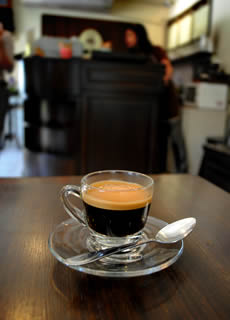 |
|
In 1904, a Thai Muslim got a Robsta coffee plant in Sumatra, Indonesia on his way home from Mecca on pilgrimage, and started cultivating in the southern province Songkhla - this is the origin of Thai coffee traditionally said. Indonesia, which also belongs to Southeast Asia, has 400 years of the history of coffee. Compared to that of Japan where coffee was brought by a Dutch in 1690 for the first time, we can say the history is still just in the beginning in Thailand.
In 1960, although the coffee production in Thailand was only about 750t, now the import amount of coffee beans was 6,000t and exceeding the production amount by far in the same year. Then the Thailand's Royal Project had an incentive system of agricultural conversion from opium to coffee, for ethnic groups in mountainous regions so as to increase the coffee production amount. As soon as the system had prospered, the cultivation of Robsta has started about 25 years ago, and the production had dramatically increased to 82,000t (approx. 1.37 million coffee bags), and the import amount was 48,000t (approx. 800,000 coffee bags) in 2000. Most of the coffee is exported to the U.S for instant coffee, and other 800-850t of Arabica coffee is mainly consumed domestically as commercial coffee. This is the main reason why Thai coffee is not that popular in Japan.
However, some of them are specialty coffee as the one we offer in our cafe, "Hope of Thai". |
|
| |
By the way, there is a staff who has a bit extraordinary career in our company - Momo Hirai (Hankyu Umeda branch, working since 2011).
After graduating her university, she left for Thailand by herself and contributed to continuing the program mentioned above as a member of NPO. After coming back to Japan, she has entered our company with a dream that she would like to tell consumers in Japan about the Thai coffee that she had contributed to the production. I feel there must have been a strong fate and luck with her between Khun Chaan Khian, don't you? In this report, we would like to mention the journey to the village with her. |
|
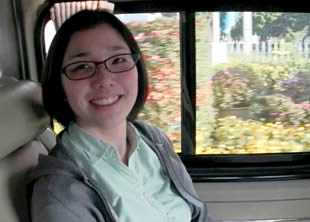 |
|
| |
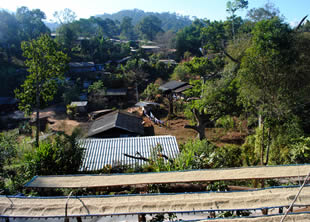
Khun Chaan Khian Village. While Hmong People have an elegant demeanor, they seem to have been skillful soldiers. |
|
About one and a half hour ride from Chiang Mai in North Thailand, Khun Chaan Khian Village is located in the middle of the National Forest Conservation Area.
Out of 10 sorts, 1 million ethnic people living in mountainous region in Thailand, there are Hmong People who are said to be active and taking the leadership. We have visited one of their villages in the end of January, which was the end of harvest time and the village was quite enlivening. |
|
| |
For a further explanation, although coffee was brought into the village with plum and lychee about 30 years ago when they had agricultural conversion of the Royal Project, the villagers had been totally indifference toward coffee for a while; they did not have a habit of drinking coffee at that time, and securement of a sales chain. Therefore, coffee trees had been left without harvesting for a long time. The villagers' thoughts toward coffee has been gradually changing, and more and more people have started producing coffee with a guidance of the Chiang Mai University - Momo is one of the members who had assisted in the project. |
|
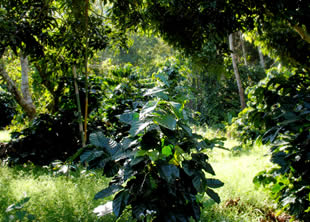
You can see a lovely picture of coffee farm in a forest. |
|
| |
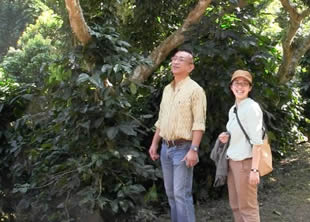
Taking a rest in the shade of a lychee tree. |
|
While inspecting some typical farms in the village, you would take notice of the tidily maintenanced paths there. Imagine the Japanese typical rural landscapes.
Crops are grown in an ordinary line in weed less footpaths. Nowadays, in Japan, most farmers use agricultural chemicals in fields for cash crops to prevent the appearance of harmful insects or weeds. Unfortunately, my sons have never seen a landscape of rice fields with Japanese killifish or giant water bugs living. |
|
| |
The farms of Khun Chaan Khian is surrounded by so many trees as to make it hard to recognize them from forest around there - However, if you see them with straining your eyes, you will notice that all paths are moderately weeded by hand, and there are lychee trees, which supply phosphorus and nitrogen to prevent soil from drying, planted among the coffee fields. There is little banana tree which is often used for shade tree of coffee cultivation.
Actually, banana cultivation is sometimes troublesome despite of its fast growth and high liquidity. The market has become oligopolistic owe to some major dealers, and the product standard is strictly fixed. Those bananas for sale are all to be soaked in medicine. Additionally, banana plantation is unsuitable for irrigation areas because banana tree absorbs lots of water more than needed, even from other plants. |
| |
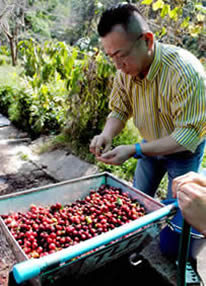
Peeling the silver skin and checking the seed inside. |
 |
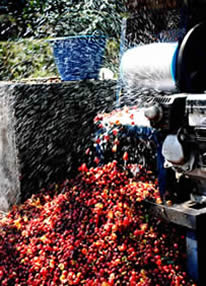
The peeled skin becomes good manure. |
 |
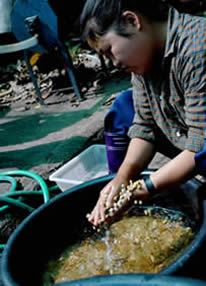
The process of washing the beans patiently in cold water is quite tough despite of its suppleness. |
|
All the hand-picked coffee cherries are gathered in the refinery and processed during the day. The color of cherries is all bright red, which indicates they are almost ripe (Actually, this is the hardest point to make harvesters to pick up only uniform-colored berries. I have even suspected that if Latin harvesters could distinguish difference between red and green sometimes... seriously). Although the color seems to be a bit unripe compared to dark-red colored coffee in highlands (1500m-3000m above sea level), apparently "this is the best", according to a professor in the Chiang Mai University. In fact, small farming families have to walk for 1-2 hours to get to the refiner and back every time they bring harvests. Considering the fast degradation of cherries, this is truly the exact timing so as to uniform the quality of all cherries. Not only choice of shade trees but also that of harvest timing is well-considered and practiced.
Momo says "In Thai culture, people have respects for seniors like leaders, parents, and elders, and you are supposed to follow their instructions. So once you get consent with them, there is no problem with the community. You have only to trust them obediently as they told". It sounds like some big plantation owners in Central America would come hitting the whole village for headhunting with a sum of huge money once they heard it... I suppose. |
| |
 |
| |
I believe that it is one of my duties to connect the producers and consumers, but I am sure to make a clear distinction.
"Consideration will be paid only for valuable things."
Consumers have a right to demand a better taste, and producers have a obligation to pursue it.
Our activity can be linked to the thoughts of Win-Win only after the relationship has built. Nevertheless, there are still a number of cases that has brought a bad influence because of an excessive assistance and support, and didn't lead to the goal they had planned. Sustainability will be realized only when the consideration is paid to an equivalent value which came from workers' efforts. |
| |
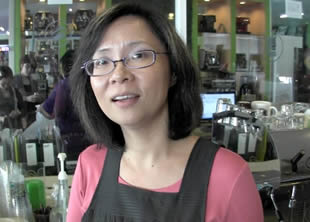
Go-getter woman (Momo says), Naru-san. |
|
So, let's go on to the main question - what about the quality of Thai coffee? The answer is not "This is the best", at least I think. I mean, "Not the best, but there is a number of diamonds in rough that might be specialty". In fact, we have started offering the coffee of the village since our quality manager judged the taste was fine enough without considering its background, rather than for volunteering. Considering the potency of terror and their earnest national characteristics, there may be another village like Khun Chaan Khian around the world with high possibility.
We had an opportunity to talk with a buyer of Khun Chaan Khian coffee, Naruemon Taksa Udom at the Hillkoff, which has been developing in Chiang Mai. |
|
| |
“The quality of the coffee of villages around Khun Chaan Khian has been getting better and better, and internationally evaluated as it received a prize at the 7th World Cup Tasters Championship in London. I think it is my responsibility to keep sharing information with workers for more improvement of coffee quality, and introduce them to consumers.
I take it for granted that quite a few Thai people who have been closely connected as both producer and consumer have much more enthusiasm than us. |
| |
 |
| |
| Eventually, we have visited Meh's (means mother in local language) where Momo used to be staying while her working there. |
| |
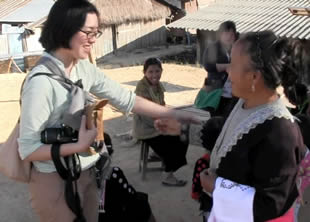
Reunion with Meh. |
 |
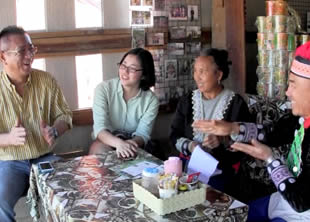
Pleasant time with Poh (means father) |
|
| |
Having been listened to a musical conversation of Meh and Momo, I was thinking about "the difference of happiness" between some who are being pressed for time like us and others who are leading a slow life surrounded by nature like the villagers.
Then a key word "closeness to nature" flashed into my mind. In rural districts, there is always a number of wisdom of the ancients for coexisting with nature, and there are common thoughts to the Japanese idea of "Satoyama Woodlands" in taking well care of nature. Unforetunately, there is a discriminatory assumption among Thai city dwellers that the ethnic people in mountainous region are "poor countly folks" or "living in the national park without an approval. |
|
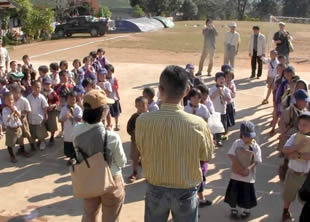
Visited students of an elementary schoool there with a welcoming song. |
|
| |
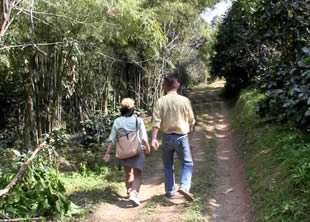 |
|
Recently, there was a case that a Thai forrest office had set a fire to some houses (simple but fine ones made by bamboo) and a rice granary in the village, with a foced reason that one of the ethnic people Karen had squatted in the national forest conservation area.
The way of life of "country folks" should be "to live without defying nature", and isn't it an ideal life that would bring true happiness?
This is quite ordinal but nature is not always convenient for humans.
Sometimes it brings us a disaster.
So we have to live together in cooperation in nature. |
|
| |
Living closely to both nature and people.
They well know the importance of coperating with others rather than keep asserting oneself.
It doesn't lead to happiness for us to try to control everything since we are part of nature.
As we need an alarm clock for waking up at fixed time.
I can tell one thing:
There is no alarm clock in Khun Chaan Khian. |
Mitsuhiro Yamamoto
HIRO COFFEE Representative Director |
|